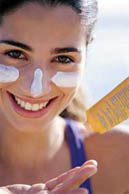How to choose an effective sunscreen
These days going out to sun oneself is fraught with a myriad of risks. Besides sunburn one has to keep in mind the fact that the ultraviolet rays of the sun have the ability to case skin cancer. Perhaps that is the price of global warming, but it is a fact nonetheless.

Given such a scenario, it is imperative that the correct methods are used to protect your skin from the sun. It is here that the user needs to be cautious and choose wisely from the wide array of products that dominate the market. Tall claims made by sunscreen manufacturers are best taken with a pinch of salt. Recently the manufacturers were under the cosh because they made false claims on the labels.
The July issue of Mayo Clinic Women's HealthSource contains some useful tips on how to go about choosing the right sunscreen for your skin. The report says that an average adult requires 1 ounce of sunscreen that is equivalent to 2 tablespoons, for covering the whole body.
The first thing to look for in a sunscreen is protection from ultraviolet A (UVA) and ultraviolet B (UVB) sunrays. Both are equally harmful. Secondly a sun protection factor (SPF) of 15 is the bare minimum that deflects about 93 percent of the UVB rays. It also enables you to remain in the sun for a longer time.
The third factor to note is the water resistant and water proof qualities. This is vital if you sweat a lot or are planning to swim. "Water-resistant sunscreen protects for 40 minutes; waterproof sunscreen for up to 80 minutes," the report says, reports Earthtimes.
According to BusinessWeek, even the best sunscreens wear off, so reapply them every couple of hours, especially if you've been sweating or swimming. And know when you've had enough. A good way to keep track of your cumulative exposure is to get one of the new products that react to UV light. SunSignals self-adhesive patches, $5 for a pack of 18, gradually change color to a bright orange when exposed to UV rays, warning you to reapply your sunscreen or go inside.
A better bet is an electronic UV monitor, which costs about $25 or $30. La Crosse Technology makes one that looks like a sports watch, or there are styles you can wear around your neck from Chaney Instrument and Oregon Scientific. Program them with your skin type, from fair to dark, and the SPF of your sunscreen. They calculate the strength of the days's UV rays and use that to count down the time you can stay outside safely. Oregon Scientific's model is splash-proof and includes a digital thermometer.
Jason Rivers, a dermatology professor at UBC, however, says that the benefits of sunscreen far outweigh any possible risks.
As many as 20 percent of Canadians have an "irritant reaction" to sunscreen, Rivers told the Straight, and fewer are actually allergic. A common allergen in commercial sunscreens is the chemical benzophenone, he said, which also goes by the names phenyl ketone, diphenyl ketone, or benzoylbenzene. Although it isn’t clear how much of benzophenone is absorbed into the bloodstream, the substance has been found in urine samples of study participants. Nevertheless, he maintains that sunscreens are safe.
"There’s no evidence these ingredients cause changes to cells or are carcinogenic in their own right," said Rivers, who’s also a spokesperson for the Canadian Dermatology Association. "There’s no evidence they have a negative effect on vitamin-D metabolism. There is evidence to support they prevent sunburn and reduce premature aging of the skin and the risk of certain cancers," reports Georgia Straight .
O.Ch.
Subscribe to Pravda.Ru Telegram channel, Facebook, RSS!




